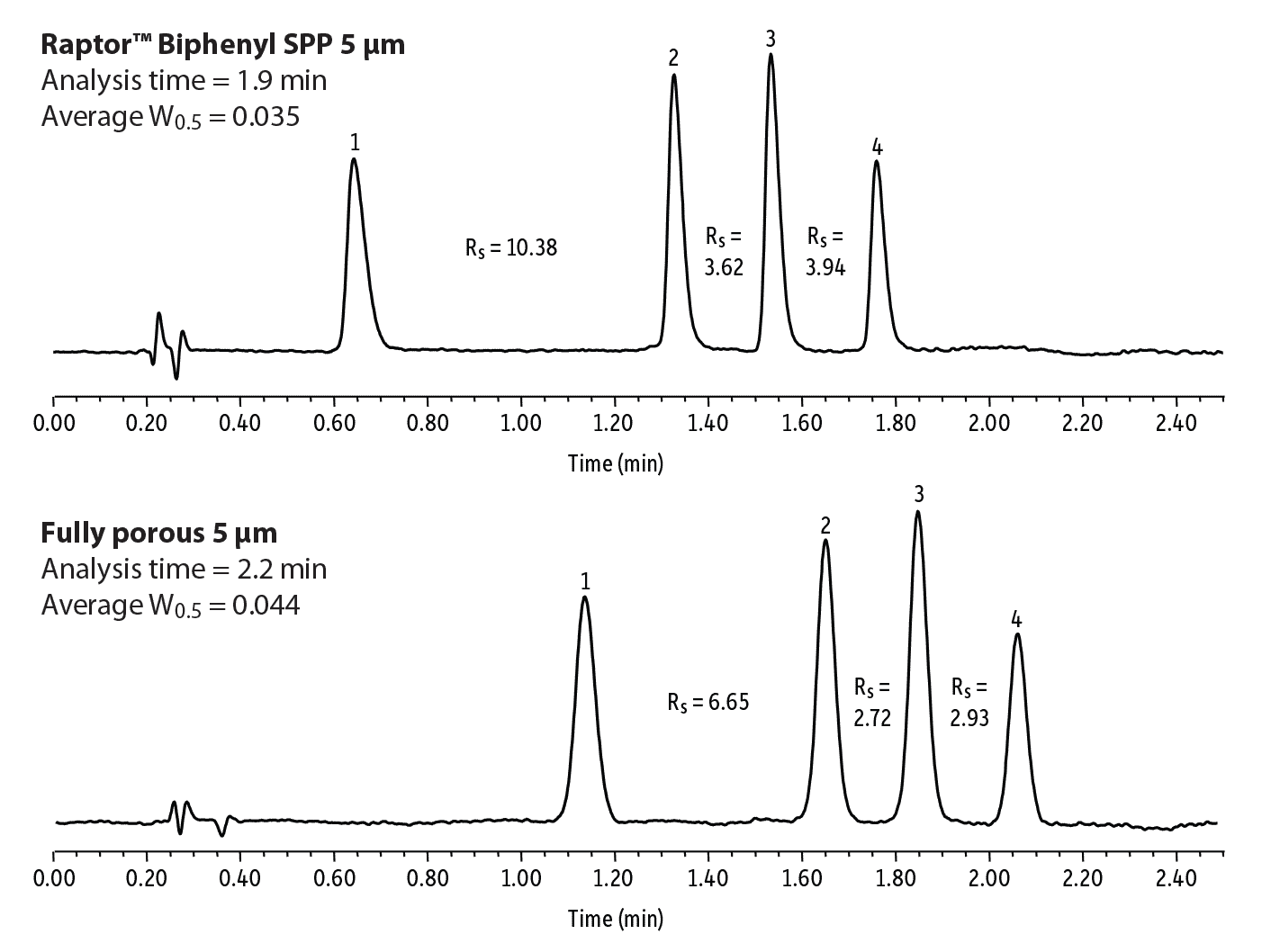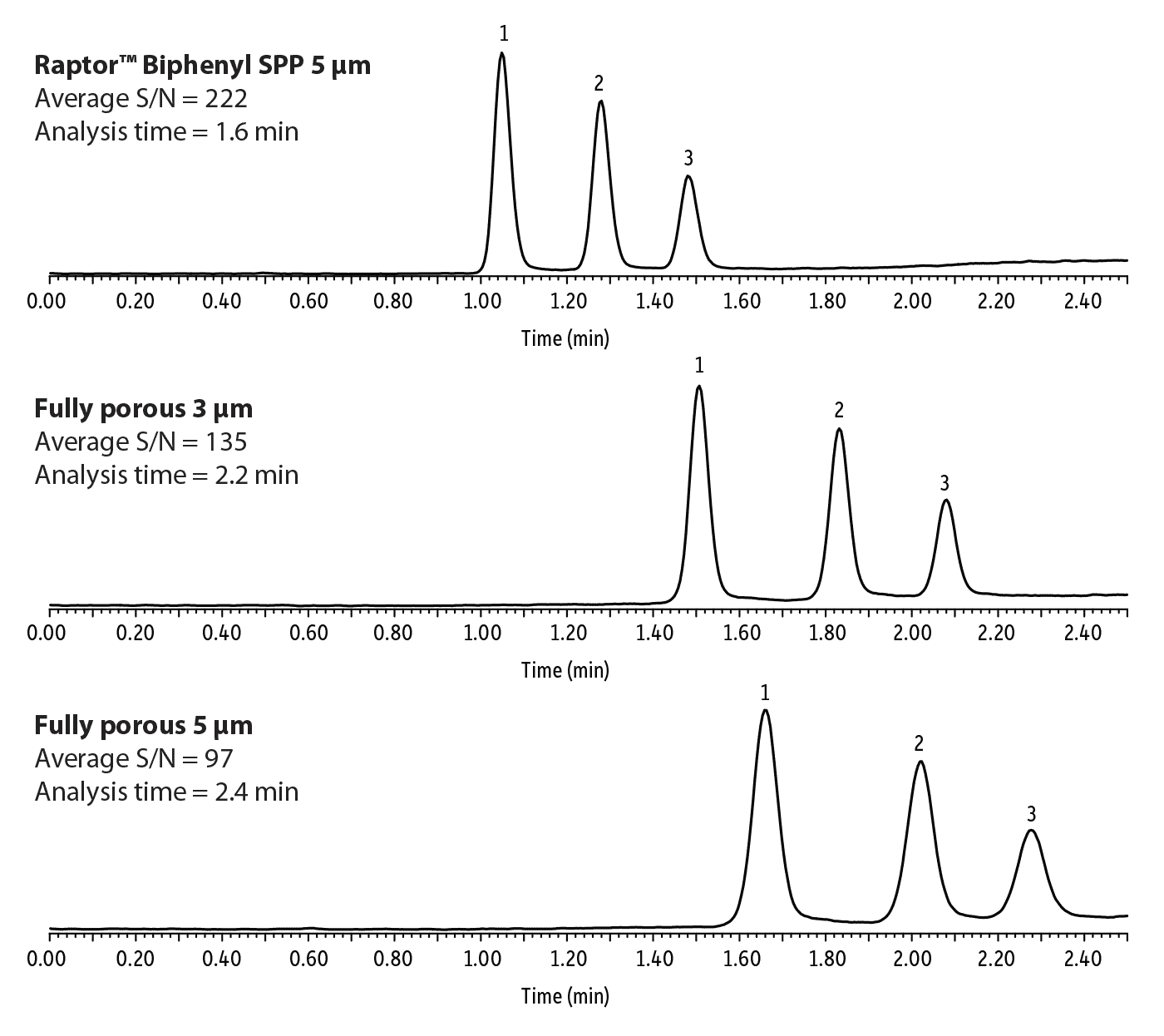The Effects of LC Particle Choice on Column Performance: Switching from 3 and 5 µm Fully Porous Particles (FPP) to 5 µm Superficially Porous Particles (SPP)
Introduction
Superficially porous particles (commonly referred to as SPP or "core-shell" particles) have been proven to provide fast and efficient LC separations. These particles feature a solid, impermeable core enveloped by a thin, porous layer of silica that offers significantly higher efficiency and sensitivity than traditional fully porous particles (FPP). In this technical note, we will compare the performance of Raptor 5 µm SPP LC columns to traditional 3 and 5 µm FPP LC columns. We will demonstrate how faster, more efficient analyses can be attained with greater sensitivity and reduced system pressure by switching from fully porous particles to superficially porous particles—without changing instrumentation.
Switching from FPP to SPP: Increased Efficiency, Decreased Pressure
One of the primary advantages of SPP is its ability to provide increased column efficiency, often with similar or even reduced backpressure, when compared to conventional FPP. By increasing efficiency while decreasing pressure, the user can achieve faster analysis times without changing instrumentation. As shown in Figure 1, column backpressure decreases by approximately 50% on average across the instrument flow rates tested (0.2 to 2 mL/min) when switching from a 3 µm FPP column to a Raptor 5 µm SPP column. Although the 5 µm FPP column displays comparable pressure to the Raptor 5 µm SPP column, it is at the expense of efficiency.
Figure 1: Switch from a 3 µm FPP column to a Raptor 5 µm SPP to cut backpressure in half.
Column: Dimensions: 150 mm x 4.6 mm ID; Temp.: 30 °C;
Mobile Phase: Water:Acetonitrile (45:55).
The ratio of theoretical plates (N) at optimal flow divided by pressure can be used as a measure of efficiency for a column. When compared for each column, the Raptor 5 µm SPP column has double the number of plates per unit pressure as the 5 µm FPP column, and four times the number of plates per unit pressure as the 3 µm FPP column (Figure 2).
Figure 2: Focusing on plates per unit pressure, switching from 3 and 5 µm FPP columns to Raptor 5 µm SPP columns offers clear advantages.
Column: Dimensions: 150 mm x 4.6 mm ID; Temp.: 30 °C;
Mobile Phase: Water:Acetonitrile (45:55); Detection: 254 nm; Test Probe: Biphenyl.
Alternatively, the relationship between efficiency and pressure can be illustrated by comparing the theoretical plates of each column while holding pressure relatively constant (Figure 3). Again, the Raptor 5 µm SPP column shows a dramatic increase in efficiency at equivalent pressure.
Figure 3: With equivalent pressures, Raptor 5 µm superficially porous particles exhibit significantly more plates than 3 and 5 µm fully porous particles.
Column: Dimensions: 150 mm x 4.6 mm ID; Temp.: 30 °C;
Mobile Phase: Water:Acetonitrile (45:55); Detection: 254 nm; Test Probe: Biphenyl.
The Raptor 5 µm column has nearly twice the plates (i.e., greater efficiency) as the fully porous 3 and 5 µm particle columns.
Switching from FPP to SPP: Increased Efficiency, Faster Run Times
The invention of SPP has provided analysts with fast separations without the need for expensive Ultra High Performance Liquid Chromatography (UHPLC) instruments, thereby increasing sample throughput without capital investment. To investigate the increased speed and efficiency of superficially porous particles, the Raptor Biphenyl 5 µm SPP column was compared to columns packed with fully porous 3 and 5 µm particles by performing an assay using identical instrumentation and isocratic method conditions (Figure 4).
Figure 4: Cut analysis times almost in half by switching to 5 µm SPP with lower pressure over 3 µm FPP and far superior efficiency over 5 µm FPP.

| Peaks | Conc. (mg/mL) | |
|---|---|---|
| 1. | Uracil | 0.02 |
| 2. | Benzene | 3.0 |
| 3. | Naphthalene | 0.5 |
| 4. | Biphenyl | 0.06 |
| Column | |||||||||||||
|---|---|---|---|---|---|---|---|---|---|---|---|---|---|
| Temp.: | 30 °C | ||||||||||||
| Standard/Sample | LC Reversed Phase Test Mix #1 (cat.# 35005) | ||||||||||||
| Diluent: | Methanol:water (75:25) | ||||||||||||
| Inj. Vol.: | 2 µL | ||||||||||||
| Mobile Phase | |||||||||||||
| A: | Water | ||||||||||||
| B: | Acetonitrile | ||||||||||||
|
| Detector | DAD @ 254 nm |
|---|---|
| Instrument | HPLC |
| Notes | All columns were 150 mm x 4.6 mm ID. Values for efficiency (N) were calculated from the Biphenyl peak. |
The last analyte eluted on the Raptor Biphenyl 5 µm column in 7.1 minutes resulting in a 45% decrease in analysis time compared to the 3 µm and 5 µm fully porous particle columns, which had run times of 13.6 and 12.9 minutes respectively. In addition, a 43% improvement in efficiency was observed for the Raptor Biphenyl 5 µm SPP column over the 5 µm FPP column. The 3 µm FPP column displayed only slightly less efficiency but nearly double the backpressure of the Raptor Biphenyl 5 µm SPP column.
Switching from FPP to SPP: Increased Sensitivity, Better Performance
The performance of existing methods can be instantly improved by replacing conventional 3 µm or 5 µm FPP columns with the Raptor 5 µm column. Enhanced method efficiency, peak width, and analysis time can be achieved under gradient conditions, as demonstrated in Figure 5.
Figure 5: Increase resolution and decrease analysis time by switching from FPP to Raptor SPP columns.

| Peaks | |
|---|---|
| 1. | Norfentanyl |
| 2. | Acetyl fentanyl |
| 3. | Fentanyl |
| 4. | Sufentanyl |
| Column | |||||||||||||||||||||
|---|---|---|---|---|---|---|---|---|---|---|---|---|---|---|---|---|---|---|---|---|---|
| Temp.: | 30 °C | ||||||||||||||||||||
| Standard/Sample | |||||||||||||||||||||
| Diluent: | Water | ||||||||||||||||||||
| Conc.: | 25 µg/mL | ||||||||||||||||||||
| Inj. Vol.: | 1 µL | ||||||||||||||||||||
| Mobile Phase | |||||||||||||||||||||
| A: | Water + 0.1% formic acid | ||||||||||||||||||||
| B: | Methanol + 0.1% formic acid | ||||||||||||||||||||
|
| Detector | PDA @ 210 nm |
|---|---|
| Instrument | HPLC |
| Notes | All columns were 50 mm x 2.1 mm ID. |
Average resolution values were 6.0 on the Raptor Biphenyl 5 µm SPP column and 4.1 on the 5 µm FPP column. In addition to a shorter run time, average analyte resolution increased 46% when switching to superficially porous particles of the same diameter.
In another example using gradient conditions and mass spectrometry, the analysis time decreased from 2.3 minutes on the 5 µm FPP column to 1.5 min on the Raptor Biphenyl SPP 5 µm column (Figure 6). Meanwhile, average sensitivity for the 5 µm SPP column increased by 64% over the 3 µm FPP column and 128% over the 5 µm FPP column.
Figure 6: Raptor 5 µm SPP columns also provide increased sensitivity over 3 or 5 µm FPP columns.

| Peaks | |
|---|---|
| 1. | 3,3',5-Triiodo-L-thyronine (T3) |
| 2. | 3,3',5-Triiodo-L-thyronine (rT3) |
| 3. | L-Thyroxine (T4) |
| Column | |||||||||||||||||||||
|---|---|---|---|---|---|---|---|---|---|---|---|---|---|---|---|---|---|---|---|---|---|
| Temp.: | 40 °C | ||||||||||||||||||||
| Standard/Sample | |||||||||||||||||||||
| Diluent: | Water:methanol (35:65) | ||||||||||||||||||||
| Conc.: | 1 ng/mL | ||||||||||||||||||||
| Inj. Vol.: | 2 µL | ||||||||||||||||||||
| Mobile Phase | |||||||||||||||||||||
| A: | 0.1% Formic acid in water | ||||||||||||||||||||
| B: | 0.1% Formic acid in methanol | ||||||||||||||||||||
|
| Detector | MS/MS |
|---|---|
| Ion Mode: | ESI+ |
| Instrument | HPLC |
| Notes | All columns were 100 mm x 2.1 mm ID. |
Conclusion
Raptor 5 µm LC columns with superficially porous particles (SPP) display lower backpressure and increased efficiency when compared to columns packed with 3 and 5 µm fully porous particles (FPP) of similar dimension. When used in the development of new assays, Raptor 5 µm SPP LC columns offer fast run times and excellent method performance without upgrading instrumentation. When substituted into existing methodologies, switching from conventional 3 µm and 5 µm FPP columns to Raptor 5 µm SPP LC columns has the potential to dramatically decrease analysis times while improving efficiency and sensitivity. Certain assays may require some degree of method development to achieve optimal results, but Raptor 5 µm LC columns are compatible with most assays and offer an excellent way to increase performance without extra cost or labor.

